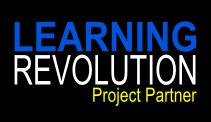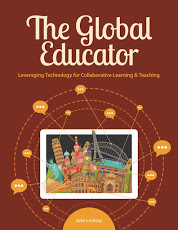Jeff Utecht
Shanghai, China
Blog: http://www.thethinkingstick.com/ and http://www.utechtips.com/
Bio
Jeff Utecht is an international educator currently working in Shanghai, China. Prior to Shanghai. Jeff has presented at both Administrative conferences and Teacher conferences around Asia and the Far East. Recently he helped to successfully organize the Learning 2.0 conference in Shanghai, China. The first technology conference of its kind in Asia aimed at bringing International schools together around technology.
Bio Page
https://k12online07presenters.wikispaces.com/Jeff+Utecht
Presentation Title
“Sustained Blogging in the Classroom”
Description
Starting to use blogs in your classroom is one thing, actually embedding them into how you teach and sustaining them as a learning tool over time is something completely different. In the past 3 years, Jeff has helped numerous teachers set up blogs with their students. Some have continued to use blogs as a learning tool, others have given up not able to sustain blogging in their classroom. In this presentation we’ll look at some ways that you can successfully embed blogs into your daily routine and look at examples from teachers around the world who have made blogging part of just what they do in the classroom.
Presentation
iPod ready
http://k12online.wm.edu/jublogging.mp4 (23:09 Run Time, mpeg4, 36.6 MB)
Original
http://k12online.wm.edu/jublogging.mov (23:09 Run Time, mov, 291.1 MB)
Audio only
http://k12online.wm.edu/jublogging.mp3 (23:09 Run Time, mp3, 5.4MB)
Supporting Links
http://thinkingstick.wikispaces.com/Sustained+Blogging
What is “Take My Hand”?
“Take My Hand”
[tags]k12online07cl08, k12online07[/tags]








Thank you so much for this presentation! I’ve had a blog set up, but I’ve done exactly what you are warning about! It has sat on the sidelines and not really been used much. I’m planning to change part of the morning routine I have with my 4th grade students to incorporate reading and writing to blogs. I am also going to find other blogs for my kids to read and make connections!
Tracie,
Glad you found the presentation worth your time. You can use the links in the wiki to start creating a network for your students. Mark Ahlness has a pretty good network started that you can tap into at the elementary level. You can also check out the 600+ student blogs here at my school http://www.saschinaonline.org they range from 4th to 12th grade so be careful of content. 🙂
This is a very informative presentation Jeff. Calm, reflective, well done. I especially enjoyed the ideas about assessment, the rubrics that you shared and the idea of getting kids to choose a rubric to use for assessment. This is an excellent idea. Thanks for your time.
I’m having trouble meshing my wiki and blog. I started the school year using a wiki as my classroom portal, posting assignments, documents, PowerPoints, and encouraging students to use the comments feature to ask questions or post comments.
Now, we’re blogging. Since WordPress 2.0 allows me to create pages, posts, add comments, and attach documents, I can use it as my classroom hub.
I know many teachers use both wikis and blogs. What is the best way to merge these two technologies? Should they be merged?
I understand the key word for blog is CONVERSATION, and the key word for wiki is COLLABORATION. But, don’t both tools allow for CONVERSATION and COLLABORATION?
Is it best to use one or the other or a combination of the two? If both, what is the best way to do so?
Anyone have any ideas?
Thank you for this wonderful presentation. This is such an important topic. Your comments about rearranging a room and blogging as an integrated tool in the classroom instead of an add-on rang true for me!
Lisa,
Great questions. I think you can use both blogs and wikis. It depends on the assignment or what you want students to do. WordPress does allow for some collaboration, but not in the same was a wiki does. Wikis allow you to collaborate on a document or website together. A blog doesn’t really allow you to collaborate in an easy format. You post and comment, or you can have use pages but it’s just not as easy as a wiki.
On the other hand you can comment on wikis but a blog allows you to easily follow a conversation…I haven’t found a wiki that really allows a conversation to flow.
So I do see the use of both in a classroom. Again it depends what you want the students to do. Do you want them to have a conversation on a topic or to collaborate in creating new information. Maybe students collaborate first and then have a conversation about their newly created content?
Different tools for different purposes…now if only we could get both under one login!
Jeff,
Thanks for taking the time to put together this presentation. I have been using blogs (classblogmeister) in my classes for 2 years and I appreciate some of the ideas you pointed out. My use has evolved over the years and I expect to be able to incorporate your ideas and encourage more of my students to be ‘regular’ bloggers.
My school offers teachers the use of a ‘post only’ blog which I use to post/update assignments. AND, I just recommitted to ‘regular’ updates to my own personal blog.
Thanks again for the ideas and the encouragement.
Hi Jeff,
Nice work. I’m curious to hear more about your thoughts on high school student blogging practices, since that’s my world.
One thing I typed in a draft for a future blog post* while watching your presentation is something I’m going to go ahead and share here, because I want to put it out there and see if anybody is already doing it, are interested in it, or any other thoughts. It’s this:
“Something I wish we would try more of is not peer-to-peer blog conversations – students reading and writing with their own age group – but more vertical designs. The idea of each age reading the blogs of those one year older, and writing about what they learn on their elders’ blogs to an imaginary audience of readers one year younger, creates a continuous chain of Vygotskian reading in the “zone of proximal development,” and writing-to-teach that produces the best learning. My head is not there right now, but it seems a very pedagogically powerful way to design K-12 blogging.”
There’s more in the draft, which is a monster of a post with reflections on about 10 presentations so far, but this part intrigues me.
(*And hey, I just migrated to a self-hosted WordPress blog at a new url, beyond-school.org, so I’m no longer blocked in China because of Blogger)
Hi Jeff,
My first comment didn’t seem to go through, so please delete this one if I’m wrong (good thing I copied it before submitting!):
Nice work. I’m curious to hear more about your thoughts on high school student blogging practices, since that’s my world.
One thing I typed in a draft for a future blog post* while watching your presentation is something I’m going to go ahead and share here, because I want to put it out there and see if anybody is already doing it, are interested in it, or any other thoughts. It’s this:
“Something I wish we would try more of is not peer-to-peer blog conversations – students reading and writing with their own age group – but more vertical designs. The idea of each age reading the blogs of those one year older, and writing about what they learn on their elders’ blogs to an imaginary audience of readers one year younger, creates a continuous chain of Vygotskian reading in the “zone of proximal development,” and writing-to-teach that produces the best learning. My head is not there right now, but it seems a very pedagogically powerful way to design K-12 blogging.”
There’s more in the draft, which is a monster of a post with reflections on about 10 presentations so far, but this part intrigues me.
(*And hey, I just migrated to a self-hosted WordPress blog at a new url, beyond-school.org, so I’m no longer blocked in China because of Blogger)
Clay,
We think alike! Last week I finished a portal that allows students at our school to easily read blog posting from other students. If you go to http://www.saschinaonline.org you will see a couple different things.
1. Down the middle in the main column is the latest blog posting from all our students (600+). I love stopping by here and looking at what is being blogged about at that moment. You could read a 4th grader or a 12th grader. You can get a reflection on a math assignment or read about a book review. We run WordPressMU and I installed the site-wide feed plugin that takes all the posting from all the sites and puts them in one feed. I then added that feed to this WordPress installation to have them in an easy to find place.
One thing that has come up is that you can’t control what students are reading. So a 5th grader could find a 12th graders posting on Freud from Psychology class…so it’s not perfect.
2. Down the right hand side you will see all the categories that students have created and posted in. So, if you are a math teacher you can scroll down to math and look at all the posting students have categorized math. You’ll notice that our Middle School is using blogging for their advisory class. The first category has over 200 postings. It’s a great way for teachers from the same subject areas to see what is being blogged about at other grade levels.
My hope is too, that this will also promote the use of categories for students. Students want to be found, they want people to read and by putting your post into the right category you up your chances of being found.
This is what I’ve done to try and promote that vertical blog conversation….will it work? Only time will tell. It still comes down to time. If teachers make time in their classrooms to allow students to read blogs, I think this is a great place to start!
Thanks for the conversation,
Jeff
Jeff – How could we get some of your high school students involved with Youth Voices – http://www.youthvoices.net
?
Jeff, that portal site looks great!
What does that plugin do to the “get a new blog” signup page on WPMU?
And what’s the name of the plugin?
I was a traffic hazard driving to work this morning, watching/listening to Vance Stevens’ tagging project presentation on K12 Online. Looking at your portal page and thinking of what Vance is experimenting with is giving me some ideas of how this might turn into the verticality we’re talking about.
But you already hint at the same idea by talking about the tagging piece.
Jeff, look for me on Twitter. Since I run the WPMU at our school (thanks to your help, among others), and since we’re 1:1 Apple and starting out HS blogging program this month, we might be able to use that tagging idea to flatten things pretty simply in a way that leads to connections between my students in Korea and yours in China. That in itself could help sustain the classroom blogging, yes?
Nice looking portal, again. Your energy is astounding 🙂
Jeff,
Wow, really great points and ideas! Thanks for including some of the stuff we do. I especially appreciated the classroom aggregator examples. I’ve thought about doing this, but have not got there yet.
The assessment piece is SO important these days when everybody’s looking almost exclusively at test scores… it’s just the times we live in I guess.
Keep an eye on classblogmeister to lead the way there once more. Teachers right now automatically get a Fleish readability score on each blog article posted by each student, with a graph for each kid, and drum roll, please…
David Warlick is working on a rubric system in classblogmeister that teachers can apply automatically to assess student writers via their blog posts.
Jeff, thanks again – great presentation! – Mark
Jeff,
Here I am in the middle of November and I can’t seem to get my classroom blog going. Thanks for this “how to” on sustaining classroom blogging. OK, now I am ready. 🙂
I have often found it interesting to hear so many teachers rave about the quality of student writing as they start using blogging in their classroom only to find they are no longer using this powerful tool months later. Thank you for this great presentation that will help me keep these educators using this tool for the long haul.
Jeff, the teacher quotes and links to examples are just what some of my elementary school colleagues need right now to focus on the purpose and place of blogs in support of reading and writing for our students. I expect to see more laptops open during SSR and more students interacting beyond our initial efforts during the 07-08 year.
Pingback: If Blogging in the Classroom Isn’t Working | Teaching Sagittarian
Pingback: Pedagogy Learning Journey #1 « To Argentina & Beyond
Pingback: Thing 4 What I think about BLOGS | Summer Learning Adventures
Pingback: Student and Teacher Blogging that Succeeds | Ideas and Thoughts
Pingback: Jeff Suther – Week 8: Blogging in the K-12 Classroom
Pingback: Week 8: Blogging in the K-12 Classroom | Erin Beal
Pingback: Connecting Students Through Blogging – 10 Tips | Chrissy Hellyer | Educator Consultant Author
Pingback: Connecting Students Through Blogging – 10 Tips - Eduro Learning